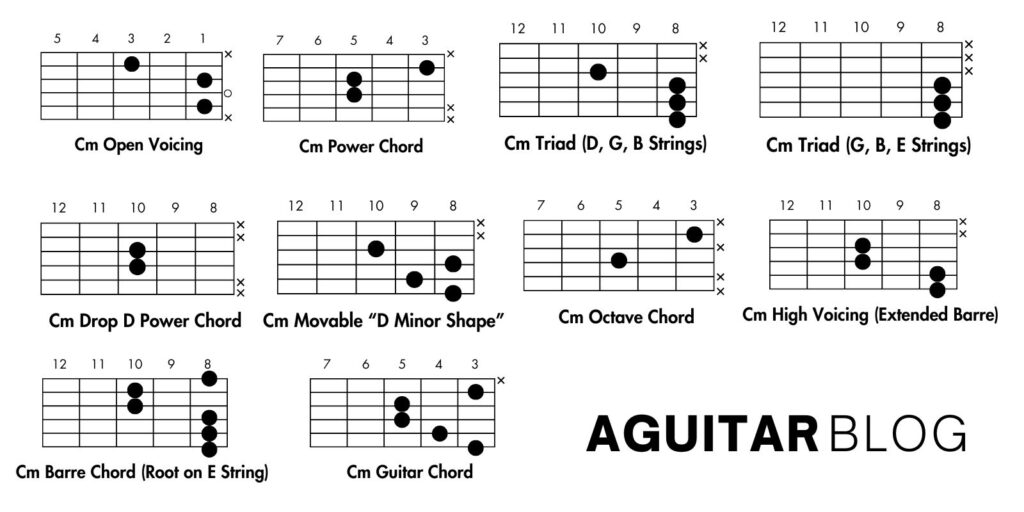The Cm guitar chord (C minor) is a must-know for every guitarist, whether you’re a beginner or an experienced player. Its rich, melancholic tone adds depth to countless songs, making it a favorite in genres like rock, pop, and jazz. But don’t worry—it’s easier to learn than you think! In this guide, we’ll walk you through simple finger positions, pro tips, and creative variations to help you master the Cm chord and elevate your guitar skills. Let’s get started!
What is a Cm Guitar Chord?
The Cm guitar chord, or C minor chord, is made up of three notes: C, E♭, and G. It’s classified as a minor chord because of the lowered third (E♭ instead of E natural) which gives it a slightly darker, more melancholic sound compared to its major counterpart (C Major). Cm is commonly used in various musical genres like rock, blues, and classical music.
How to Play the Cm Guitar Chord
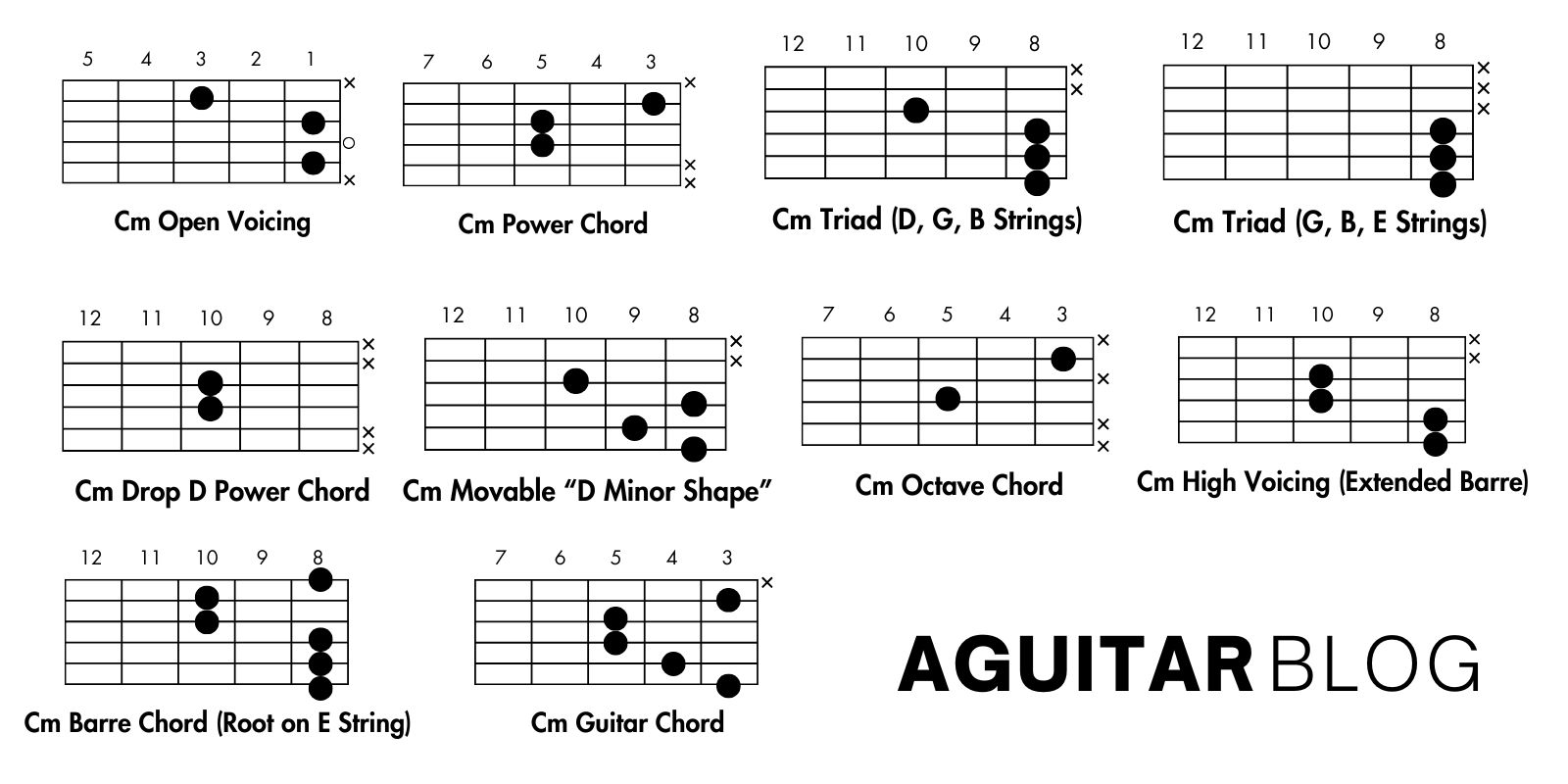
Mastering the Cm guitar chord can be a rewarding challenge, especially for beginners tackling the art of barre chords. With a little patience and steady practice, you’ll unlock its rich, emotional tone. Let’s dive into a clear, step-by-step guide to get you playing this soulful chord with confidence:
Cm Barre Chord (Root on A String)
This version delivers a deep, rich, and versatile sound. It’s ideal for creating emotional depth in ballads or providing a strong rhythmic foundation in rock and blues. Its compact shape ensures consistency in tone, perfect for strumming or fingerpicking.
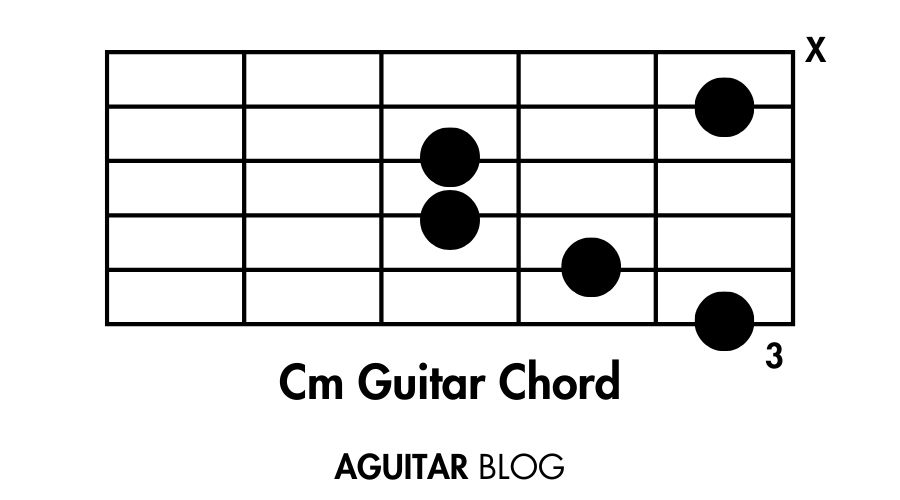
How to Play:
- Place your index finger across all strings at the 3rd fret, avoiding the low E string. This forms the barre.
- Place your ring finger on the 5th fret of the A string (G note).
- Place your pinky finger on the 5th fret of the D string (Eb note).
- Place your middle finger on the 4th fret of the B string (C note).
- Strum from the A string down to the high E string, ensuring all notes ring clearly.
Cm Barre Chord (Root on E String)
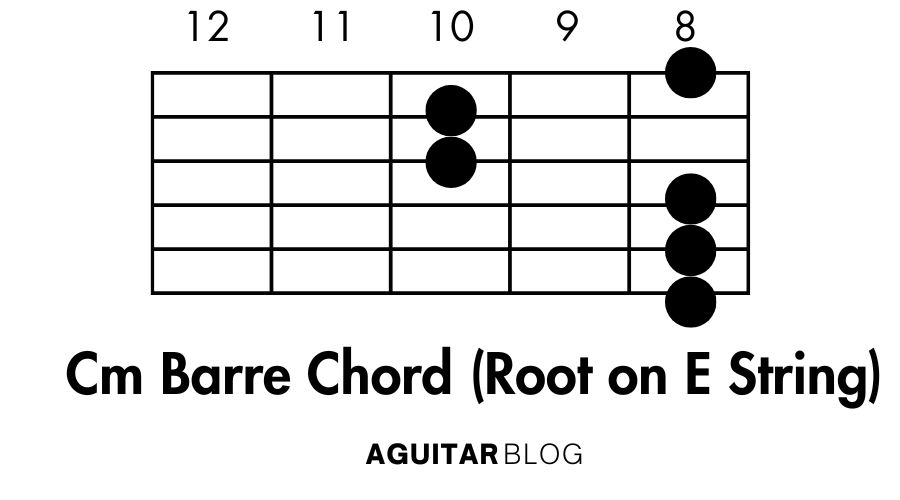
A powerful and dramatic chord with a full-bodied sound. It’s perfect for driving progressions, minor key rock riffs, or melancholic chord changes in acoustic settings. Its robust tone is versatile across genres like pop, jazz, or heavy metal.
How to Play:
- Use your index finger to barre all six strings at the 8th fret.
- Place your ring finger on the 10th fret of the A string (G note).
- Place your pinky finger on the 10th fret of the D string (Eb note).
- Strum all strings. Apply even pressure with the barre to ensure no buzzing.
Cm Open Voicing
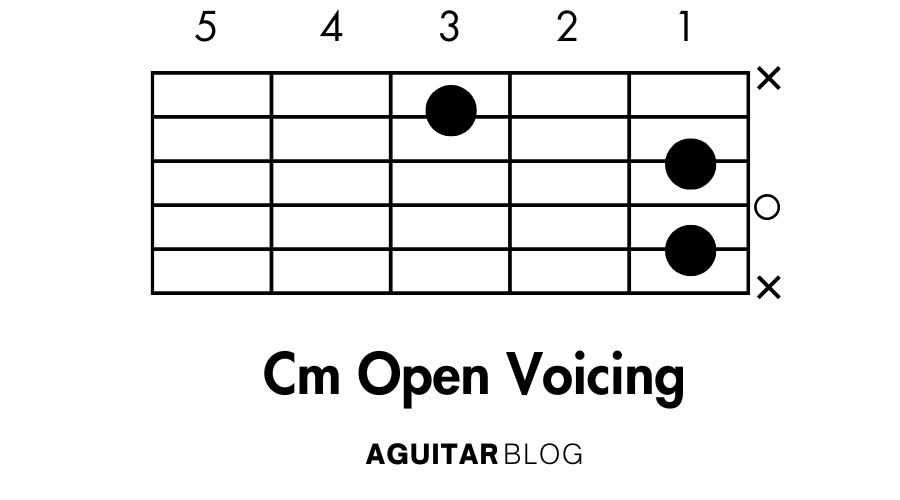
This voicing is soft and delicate, making it perfect for intros, interludes, or reflective solo arrangements. It adds an intimate, vulnerable quality to your playing, especially in fingerpicked acoustic pieces.
How to Play:
- Place your index finger on the 1st fret of the D string (Eb note).
- Place your middle finger on the 1st fret of the B string (C note).
- Leave the G string open to ring freely.
- Strum only the D, G, and B strings for a clean and bright tone.
Cm Power Chord
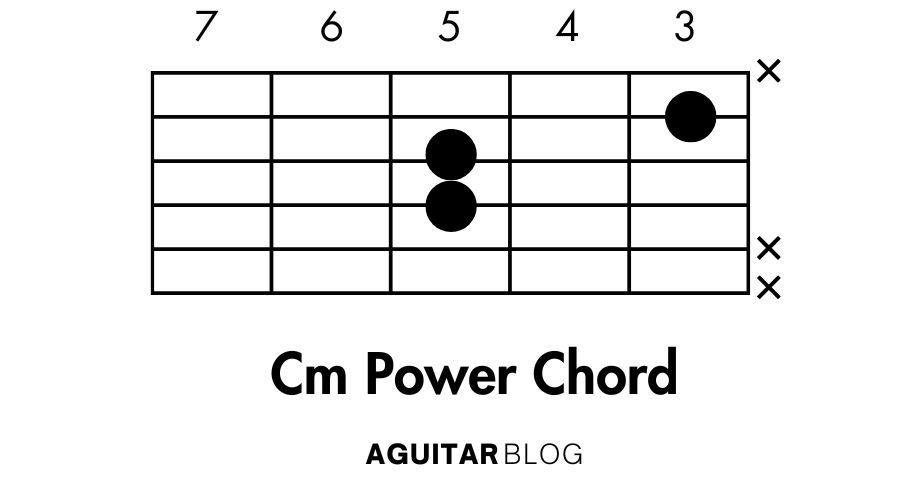
This simplified version of Cm provides a raw, punchy, and focused sound. It’s ideal for high-energy genres like rock, punk, or metal, where clarity and rhythmic drive are essential.
How to Play:
- Place your index finger on the 3rd fret of the A string (C note).
- Place your ring finger on the 5th fret of the D string (G note).
- Strum only the A and D strings for a clean, tight sound.
Cm Triad (Root Position on D, G, B Strings)
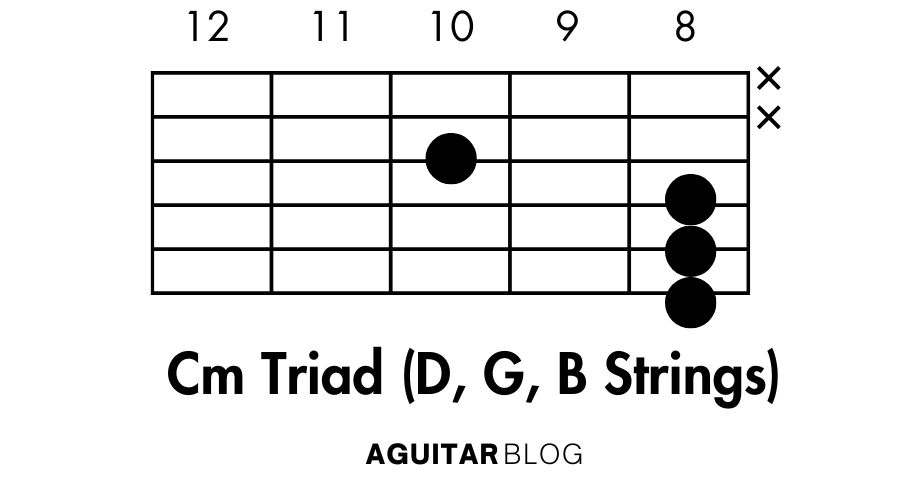
A crisp and articulate voicing that highlights the minor tonality. This variation shines in chord melodies, intricate jazz progressions, or as part of delicate fingerpicked passages.
How to Play:
- Place your index finger across the 8th fret of the G, B, and high E strings to form a partial barre.
- Place your ring finger on the 10th fret of the D string (G note).
- Strum only the D, G, B, and high E strings for a balanced tone.
Cm Triad (Inverted on G, B, E Strings)
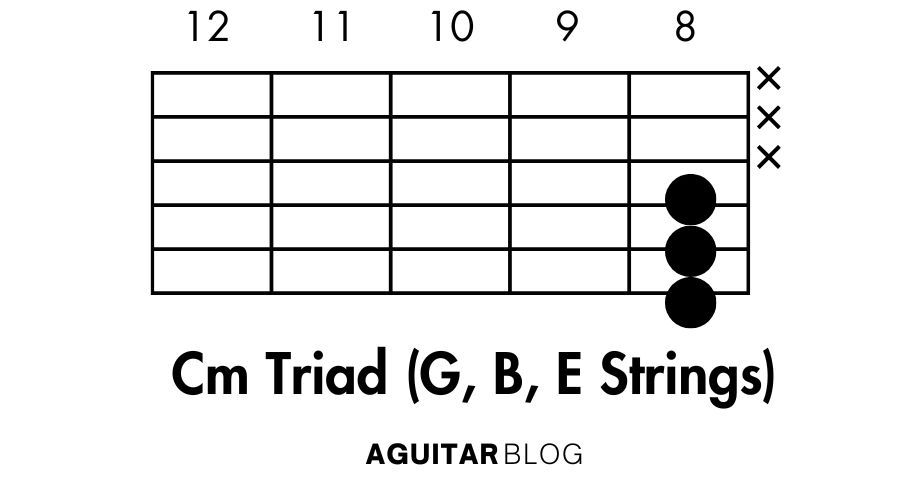
This voicing is light and shimmering, making it perfect for arpeggios or high-end layering in recordings. It has a dreamy and floating quality, ideal for intros or ambient music.
How to Play:
- Barre the 8th fret of the G, B, and high E strings using your index finger.
- Strum only the G, B, and high E strings to produce a bright, clear tone.
Cm Drop D Power Chord
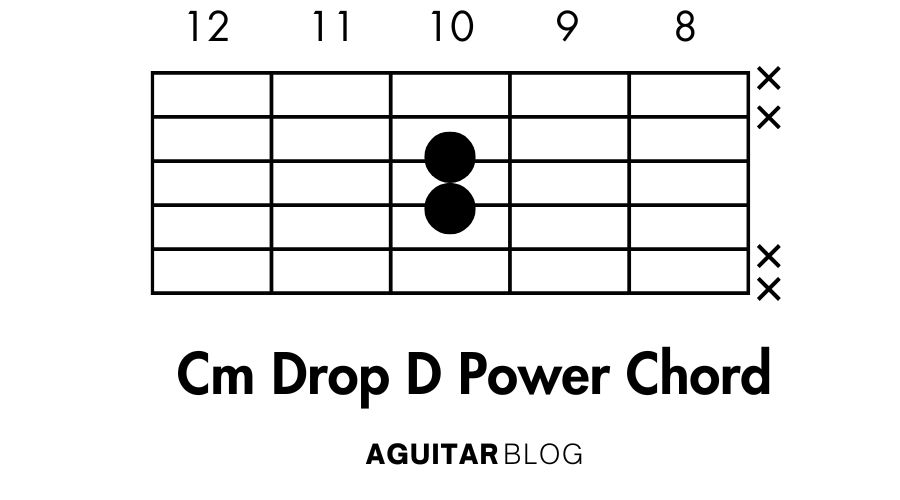
A heavy and thunderous version of Cm that excels in modern rock or metal contexts. The low end adds weight to riffs and progressions, creating a cinematic and epic sound.
How to Play:
- In Drop D tuning, place your index finger across the 10th fret of the low E and A strings.
- Strum only these strings for a clean, resonant power chord.
Cm Movable “D Minor Shape”
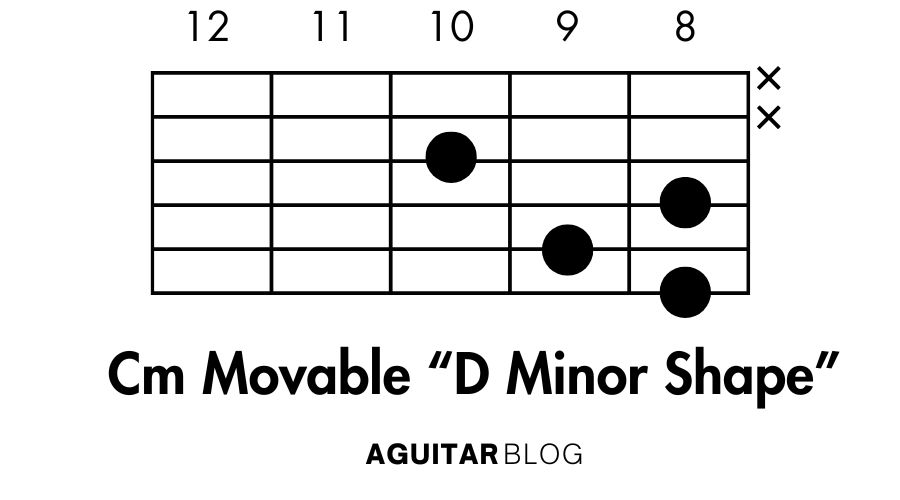
A bright, cutting variation that is easy to move along the fretboard. It’s perfect for quick transitions, solo work, or creating intricate melodic lines within chords.
How to Play:
- Place your index finger on the 8th fret of the high E string (C note).
- Place your middle finger on the 9th fret of the G string (Eb note).
- Place your ring finger on the 8th fret of the B string (G note).
- Strum the G, B, and high E strings for a focused tone.
Cm Octave Chord
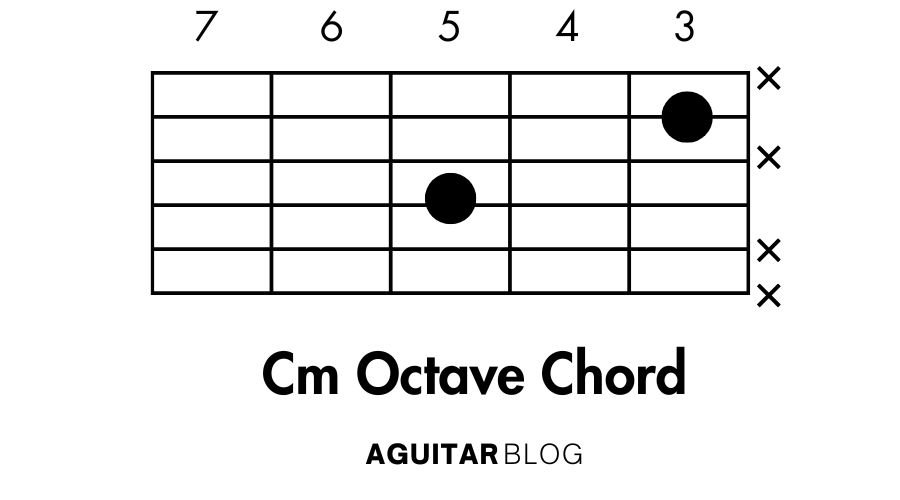
This minimalist chord delivers a rhythmic and hypnotic quality. It’s excellent for repetitive grooves, funky riffs, or as part of complex rhythm sections.
How to Play:
- Place your index finger on the 3rd fret of the A string (C note).
- Place your ring finger on the 5th fret of the G string (C octave).
- Mute all other strings by lightly resting your fingers on them.
- Strum only the A and G strings.
Cm High Voicing (Extended Barre)

This version produces an ethereal and shimmering tone, great for atmospheric playing or layered arrangements in studio work. It’s delicate yet expressive.
How to Play:
- Place your index finger across the 8th fret of the B and high E strings.
- Place your middle finger on the 10th fret of the D string (Eb note).
- Place your ring finger on the 10th fret of the G string (C note).
- Strum only the D, G, B, and high E strings for a bright, resonant sound.
Video Tutorial
For visual guidance, check out this Video Tutorial on the Cm Chord. This will show you how to position your fingers correctly and strum the chord properly.
Tips for Practicing Cm Variations
-
- Start Simple: Begin with easy shapes like the Cm Open Voicing or Cm Power Chord before progressing to barre chords.
- Focus on Clarity: Play slowly to ensure each note rings out clearly, especially in barre shapes.
- Practice Transitions: Move between Cm and other chords to improve fluidity.
- Experiment with Dynamics: Strum softly for gentle tones or harder for dramatic impact.
- Use Different Voicings: Explore high voicings (e.g., X X 10 10 8 8) or triads for added variety.
- Incorporate Songs: Practice Cm in progressions or play along with songs in a minor key.
- Strengthen Fingers: Use finger exercises and stretches to build strength and flexibility.
- Stay Consistent: Practice daily for steady progress.
“Bohemian Rhapsody” – Queen
Key: Bb Minor
How Cm is Used: Cm is featured prominently in the song’s dramatic transitions, particularly in the operatic section. Its minor quality adds tension and emotional depth, supporting the narrative’s dramatic highs and lows.
Why It’s Perfect for Practice: The frequent changes in dynamics and tempo challenge players to use the Cm chord expressively, whether strumming softly or playing with intensity.
Tips:
- Focus on smooth transitions between Cm and other barre chords.
- Use the 8th fret barre shape (8 10 10 8 8 8) to match the richness of the piano arrangement.
“Rolling in the Deep” – Adele
Key: C Minor
How Cm is Used: The Cm chord anchors the verses, driving the song’s moody yet empowering feel. It plays a central role in the song’s tension and release, setting the stage for Adele’s powerful vocals.
Why It’s Perfect for Practice: The chord’s placement emphasizes rhythm and dynamics, helping you develop control and expressiveness in your playing.
Tips:
- Use the barre chord shape (X35543) for a bold, consistent tone.
- Experiment with palm muting to mimic the percussive feel of the original track.
“Zombie” – The Cranberries
Key: E Minor
How Cm is Used: The Cm chord appears prominently in the chorus, enhancing the dark, haunting atmosphere of the song. Its raw sound underscores the emotional intensity of the lyrics.
Why It’s Perfect for Practice: The repetitive nature of the progression allows you to focus on perfecting the barre chord while playing with energy and consistency.
Tips:
- Stick to the power chord shape (X355XX) for a driving rock feel.
- Add distortion to replicate the gritty sound of the original.
“Numb” – Linkin Park
Key: F# Minor
How Cm is Used: The Cm chord plays a key role in the song’s melancholy verses, contributing to the song’s emotional and introspective tone. It’s often used alongside power chords for a modern rock sound.
Why It’s Perfect for Practice: This song is ideal for practicing tight, rhythmic strumming and smooth power chord changes.
Tips:
- Use the barre chord (X35543) for a full, resonant tone or the power chord (X355XX) for a punchy effect.
- Practice with a metronome to match the track’s steady tempo.
“Chandelier” – Sia
Key: C Minor
How Cm is Used: Cm serves as a foundational chord in this song, lending a dramatic and soaring quality to the powerful chorus. Its minor tonality enhances the song’s raw emotion.
Why It’s Perfect for Practice: Balancing soft verses with a dynamic, powerful chorus helps players work on both subtlety and intensity.
Tips:
- Use the barre chord (X35543) during the chorus to match its dramatic flair.
- Try fingerpicking the Cm chord in the verses for a more delicate, introspective feel.
Key Takeaways for Practicing These Songs
- Focus on dynamics: Match the emotional tone of each song, from soft and reflective to bold and powerful.
- Experiment with voicings: Barre chords, power chords, and open variations all have their place in these tracks.
- Pay attention to transitions: Smoothly changing between Cm and other chords is key to nailing the progression.
These five songs offer a variety of ways to explore the Cm chord, helping you develop technical skills and expressiveness in your playing
Mastering the Cm chord through these iconic songs not only enhances your technical skills but also deepens your understanding of music’s emotional depth. Each track offers unique opportunities to explore the versatility of the Cm chord, whether you’re playing soulful ballads or powerful rock anthems.
For more tips, chord guides, and song breakdowns, visit AGuitar Blog—your ultimate resource for elevating your guitar-playing journey. Keep practicing, stay inspired, and let the music flow!
SEE ALSO RELATED C CHORDS

